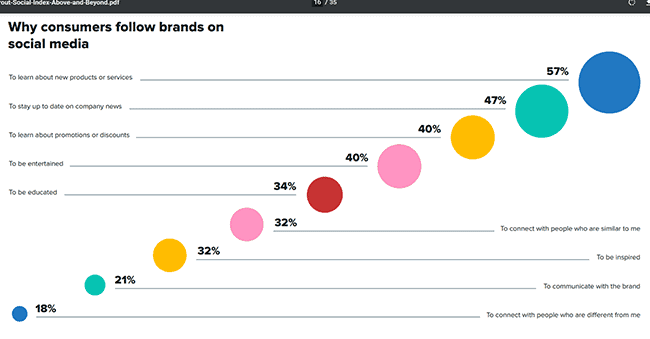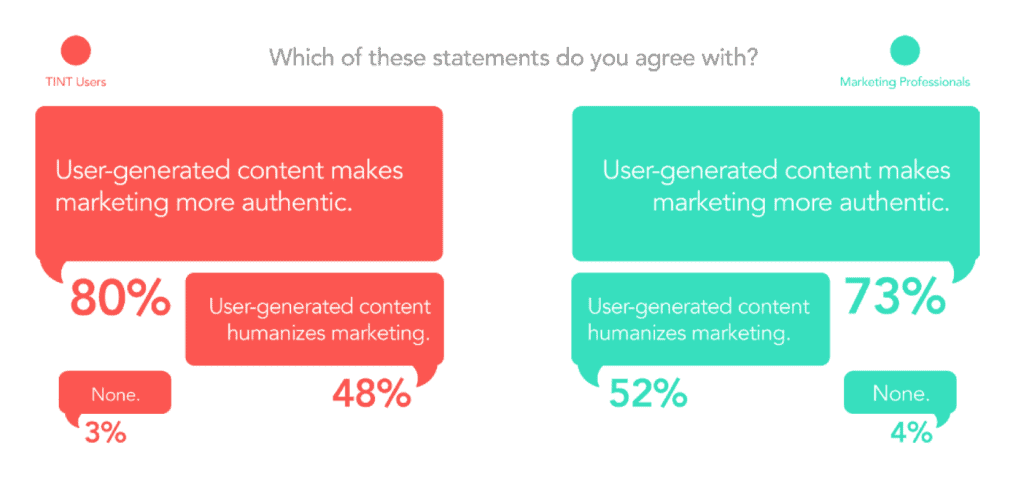Charles Darwin had a timeless piece of wisdom and business advice when he said: “In the long history of humankind those who learned to collaborate and improvise most effectively have prevailed.”
Doing digital marketing to scale your business alone is a daunting process. But you don’t always have to do it alone. In fact, you shouldn’t. In this era of endless scrolling, every business uses at least some social media channels.
[playht_player width=”100%” height=”175″ voice=”Mark”]
This has made social media collaborations easier than ever before. And it can be a very valuable and effective tool for brands and businesses. Whether you’re a small business or an established brand, you can’t underestimate the efficacy of collaboration.
So, what is social media collaboration?
In general terms, collaboration means two or more parties combine forces to achieve a shared goal. In this article, however, we are specifically talking about social media collaboration.
Social media collaboration refers to the process when brands partner up with other brands to promote each other’s products/services on their platform. This can be done in many different ways like creating a collaborative post/story with products from both brands, tagging the brand in relevant posts, using a particular hashtag related to the brand, etc.
The primary objective of social media collaboration is exposing your brand to a new audience and attracting new customers.
Why should every business consider social media collaboration?
The influence of social media in today’s world is enormous and unignorable. Social media marketing is among the best ways to expose your business to new people. The numbers speak for themselves: people are six times more likely to buy from a brand’s product page that includes images from their social media.
Moreover, people follow brands on social media for different reasons. And no doubt that the top reason is to know about new products and services as shown in the below graphic from Startupbonsai:

Credits: Startupbonsai (https://startupbonsai.com/social-media-statistics/)
This makes a great case for brands to collaborate on social media. When you collaborate with any other business then their followers will see and learn about your products/services. Besides, you can establish long-term relationships with brands having similar audiences to yours. And by maintaining those relationships you can engage in co-marketing efforts whenever it’s suitable and mutually beneficial.
How does social media collaboration work?
The process of social media collaboration starts with reaching out to another business, product owner, individual, or group with whom you want to collaborate. Once an agreement has been reached between both parties, then their social media teams will plan the type of content to be published.
When the content goes live, then it will be seen by followers of both businesses. This means products/services from either of the businesses will be viewed by a new audience and that in turn will expand their reach. Getting more exposure means more potential customers and that ultimately leads to more sales for both the businesses involved.
How to prepare an effective social media collaboration plan?
Any kind of planning involves careful consideration of many things. Social media collaboration is no exception. So, let’s see a few things to keep in mind while preparing for a social media collaboration:
1. Find a suitable brand to collaborate
This may sound obvious, but it is absolutely crucial that you find a brand that actually cares about your products/services. Otherwise, your collaboration will lack genuineness, and you will experience lack of efforts and half-heartedness from the brand you are collaborating with. And you certainly wouldn’t want any of that.
The primary aim of social media collaboration is getting your business exposed to a new audience. The goal isn’t to find a business with a large number of followers. You need to hit a sweet spot between quantity and quality. Find a business within your niche or related to your niche with an active social media presence and a decent engagement rate.
2. Always be mindful of your objectives
This, of course, goes without saying that the objectives behind your collaboration should always be clear. If that’s not the case, then your collaboration is unconvincing and you will have no means of measuring whether it worked or not.
And as far as objectives are concerned, it is given that increasing your reach or maybe even your following is what you’re intending. That, however, shouldn’t be your ultimate goal.
Obsessing over metrics like followers count is futile because it doesn’t necessarily mean more sales or conversions. Instead, you should evaluate your social media analytics to better understand your audience.
You need to understand that people who are seeing your brand for the first time may not show interest in buying from you immediately. If you are expecting otherwise, then it’s a massive ask. It would be much easier to have them as your newsletter subscribers for now. Because these are the raw relationships that you can nurture, which will eventually convert into leads. Besides, going by the numbers, email marketing is one of the most effective types of marketing with 4200% ROI.
One simple and common way to grow your subscriber list via social media collaboration is to ask people to submit their names and email address to enter into a giveaway or a contest.
3. Know what to expect and set deadlines
In collaboration, you will be working with many different individuals, which means the chances of things being overlooked is high. This is why both the businesses and their teams need to take accountability.
Communicating expectations and setting deadlines is a telling way to achieve accountability. Having a written strategy and setting a time when to execute them ensures that both the businesses remain on the same page.
And when it comes to schedules, they can be difficult to maintain. That is when social media automation tools like Bulkly can come in handy. Its Drip Scheduling feature allows you to schedule your posts/updates to your social media accounts to your set frequency.
4. Get people emotionally involved
Holding contests, giveaways, or promotional offers is alright. Although, when you include something that triggers emotion among people then they are likely to engage and invest more.
The idea here is that you have to think beyond just sales and leads. You have to get people emotionally involved. A few ways in which you can achieve that are by holding a virtual community event, supporting a cause, charity work, or any other way you can give something back to the community.
People will talk about your brand when they’re emotionally involved. This means your business may even reach more people and you will likely develop long-term relationships with your audience.
5. Create a social media style guide
Your brand/business must have a social media style guide to stand out from your competitors. Style guides ensure consistency of your brand tone and voice on social media platforms.
It is vital to make sure you are not compromising on your business values and authority when collaborating with other businesses. A social media style guide can come in handy in such scenarios. Your team members and the companies you partner with will exactly know what colors, fonts, layouts, graphics, and pictures to use through your style guide. Having a manual that is accessible at any time to all the members makes social media planning much more effective.
If you already have a proper guide for social media, even then you might have to amend some things to make it a proper fit for the collaboration. You have to sort out what is going to work best for both businesses.
Okay, so now you know what social media collaboration is, how it works, and how to prepare for it. And yet, you are short on ideas about collaborations.
Here are five social media collaboration ideas that you can try:
1. Reach out to brands having similar audience
Reaching out to brands with similar audiences is perhaps the ideal way to collaborate on social media. You don’t have to worry about analyzing the audience or whether they might be interested in your brand or not.
That is the biggest benefit of collaborating with brands having an identical audience as yours. You get a fresh audience who are actually interested in your brand, and similarly, it applies to the audience of the brand you are collaborating with.
For a brand to brand collaboration, you first need to identify a suitable brand having a similar audience as yours. Then you need to reach out to that brand asking whether they’re interested in collaborating with you. Once you’re onboard with a brand, you can discuss and plan about your posts or campaigns.
Reaching out to other brands is the most crucial stage for a brand to brand social media collaboration because your communication needs to be alluring and effective as well. Marketers and business owners may find it daunting. But let’s not forget: cold emails can work wonders in that regard. You don’t have to worry about crafting impactful emails. AI email writing tools and assistants can handle that in a very eloquent way.
These AI email writing tools can take off a massive burden from marketers. They don’t need to be concerned about writing and sending a bulk of emails manually.
2. Collaborate for Giveaways
Giveaways are a great way to increase your reach, boost sales, and gain loyal customers. There’s no doubt that a giveaway crossover can be so rewarding for both the businesses involved.
Giveaways typically mean giving away complimentary products by asking users to do specific tasks. These tasks can be anything from liking/sharing the post, following the businesses’ accounts to tagging and inviting friends.
When brands collaborate for giveaways, there are many mutual benefits like increasing your audience, brand awareness, inspiring your audience to try something new, and expanding into a larger market. All of these will, eventually, lead to more sales.
Many brands have successfully collaborated for social media giveaways. The recipe for a successful giveaway is pretty straightforward – you should collaborate with a brand that compliments your products and vice versa.
People are always drawn to giveaways because, in the end, winners are guaranteed to get prizes, which include products from both businesses.
3. Reach out to influencers
Collaborations don’t always have to be among brands and businesses. It can also be done with influencers or brand ambassadors, especially considering that there are a large number of them with a massive number of social media followers.
There’s a human element when you are collaborating with any influencer. Their followers usually trust them. So, if you are getting them to promote your business or products, it will have a personal touch. Influencers are human after all and when people see them as users of the product or customer, then it’s like someone they know is recommending something.
The most important thing to remember when you’re planning to collaborate with any social media influencer is to make sure that they are a good fit for your business and your niche, and they are genuinely interested in what you are offering. Otherwise, people wouldn’t bother to know more about your products/services. And your collaboration wouldn’t be ineffective because you’re reaching out to the wrong kind of audience.
Many smartphone and computer accessories brands collaborate with eCommerce influencers and gadget reviewers. This makes perfect sense because some of these influencers have a decent audience who follow them for their honest reviews and opinions on various gadgets. The same people are likely to be interested in different types of smartphone and computer accessories.
4. Take advantage of user-generated content
There’s absolutely no shortage of user-generated content. And one of the great ways to do marketing is to utilize it for collaboration.
The easiest and simplest way to obtain user-generated content is through reviews, comments, testimonials, and pictures or videos of your products on social media. People often tag brands and businesses when they buy a certain product. And this is an opportunity for brands and businesses to use it for their benefit.
Apple started the #shotoniphone campaign as a simple UGC challenge. The company shared users’ pictures taken with iPhones on their social media feeds and a few selected pictures even made it to their advertisement billboards around the world.
When you showcase user-generated content, it develops trust and makes it more reliable to people, especially those who don’t own that particular product.
This is even backed up by data – According to a survey conducted by Nosto, 60% of consumers revealed that content from their family or friends is more influential in their purchase decision than celebrities or influencers. The below infographic from TINT shows how marketers and consumers feel about how UGC influences the authenticity of marketing.
Credits: TINT (https://www.tintup.com/blog/user-generated-content-marketing-report/) 
This simply means that user-generated content is a great way to convince people to buy from you. Using user-generated content in social media collaborations can be highly effective. Consider this: a fashion brand and a jewelry brand can use photos of customers wearing their products for social media posts.
5. Guest Blogging
Guest blogging can also be an effective strategy for social media collaboration. If you connect with publishers and creatives who have respectable social media followings, then they can help you grow your social presence by sharing content on their platforms.
Working with reputed publishers and creatives can not only boost your social media but can also increase your brand’s credibility. People are more likely to trust reputed sources. So, if they are sharing anything related to your products/services, then the chances of people buying from you are higher.
You might be wondering how you will connect with such publishers and bloggers. Don’t forget that sending cold emails is among the best ways to reach out to these people. A well-drafted and clearly communicated email is more likely to get a response from professionals like social media managers, business owners, marketers, and industry experts. Also, you don’t have to worry about sending out numerous emails manually and managing a large contact list. A cold email marketing platform will take care of all that.
Wrapping Up Social Media Collaborations
That’s all you need to know about social media collaboration. Since every brand now has a presence on some social media platform, collaborating is easier than ever.
Planning and communication are extremely crucial to ace social media collaborations. You need to be transparent and you need to be in constant touch with the business you are collaborating with. You also need to have proper objectives and a game plan to follow.
Social media collaborations may seem daunting and may also present some challenges, but we are sure that if you’ve read this guide then you’ll definitely feel poised and ready about it.


